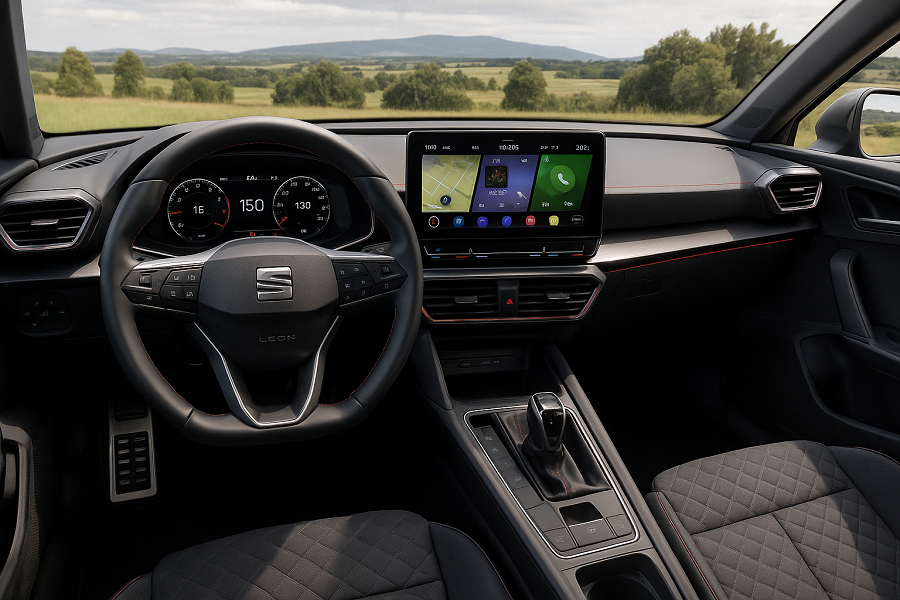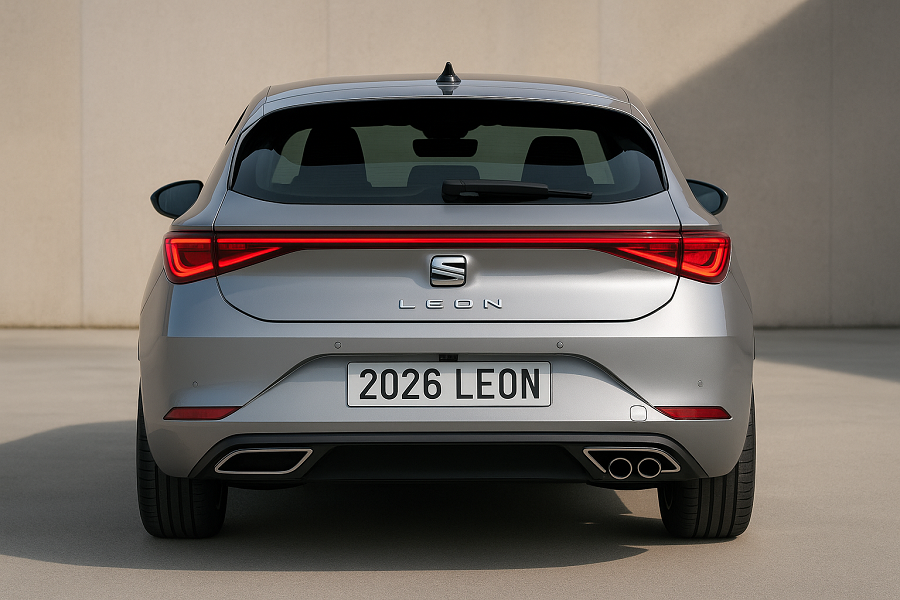Introduction
The Seat Leon has been a staple in the compact hatchback scene since its debut in 1999. Known for its sporty vibe, practical design, and wallet-friendly price, it’s carved out a loyal fanbase across Europe and beyond. Over four generations, the Leon has evolved from a scrappy underdog to a polished contender, blending Spanish flair with German engineering (thanks to its Volkswagen Group roots). The 2026 Seat Leon is the latest chapter in this story, and it’s poised to shake things up with a bold redesign, cutting-edge tech, and eco-friendly powertrains. Why does this model matter? It’s Seat’s answer to a crowded market where the Volkswagen Golf, Ford Focus, and Toyota Corolla are fighting for supremacy. Let’s dive into what makes the Seat hatchback 2026 a must-see.
Overview of the 2026 Seat Leon
The 2026 Seat Leon isn’t just a facelift—it’s a leap forward. Built on the updated MQB Evo platform, it’s sleeker, smarter, and more efficient than ever. Seat is targeting young professionals, small families, and driving enthusiasts who want a car that’s fun, practical, and tech-savvy without breaking the bank. It’s positioned as a sportier alternative to the VW Golf, with a focus on bold styling and hybrid options to appeal to eco-conscious buyers.
What’s new for 2026? Here’s the quick rundown:
- Redesigned exterior: Sharper lines and matrix LED headlights.
- Upgraded interior: Bigger infotainment screens and premium materials.
- Hybrid powertrains: Improved plug-in hybrid with over 100 km electric range.
- Advanced safety: New driver-assist systems for a safer ride.
- Sporty trims: FR and Cupra models for performance fans.
This car aims to balance everyday usability with a bit of spice, making it a standout in the compact hatchback segment.
Exterior Design & Styling
New Styling Elements
The 2026 Seat Leon looks like it’s ready to steal the show. The front grille is wider and more aggressive, with a honeycomb pattern that screams confidence. The optional matrix LED headlights (a first for the Leon) give it a futuristic edge, adapting to road conditions for better visibility. The rear gets a coast-to-coast LED light bar, adding a premium touch. It’s sporty without being over-the-top, perfect for those who want a car that turns heads without shouting.
Color Options
Seat knows how to make a car pop. The Seat hatchback 2026 comes with a vibrant palette:
- Graphene Grey: A sleek, metallic option for a modern look.
- Magnetic Tech: A deep, glossy grey that’s subtle yet striking.
- Desire Red: Bold and fiery, ideal for standing out.
- Urban Silver: Clean and classic, great for understated style.
- Midnight Black: Timeless and sophisticated, especially with the Black Pack.
Some colors, like Graphene Grey, may vary by market or trim, so check with your local dealer.
Aerodynamic Improvements
The 2026 model isn’t just about looks—it’s built to cut through the air. A lower front bumper, sculpted side skirts, and a rear spoiler reduce drag, improving fuel efficiency and stability at high speeds. These tweaks make the new 2026 seat leon specs not only stylish but also practical for long highway drives.

Interior Design, Comfort & Tech
Seating and Materials
Step inside the Leon 2026 interior, and you’ll feel the upgrade. The seats are supportive, with options for cloth, Alcantara, or leather depending on the trim. Higher-end models like the FR get sporty bucket seats with red stitching, adding a touch of flair. There’s plenty of legroom and headroom for five passengers, though taller folks might find the rear a bit snug. The boot space is generous, especially in the Sportstourer (estate) version, with up to 620 liters of cargo room.
Dashboard Layout
The dashboard is clean and driver-focused. A 12.9-inch touchscreen dominates the center, flanked by sleek air vents and minimal physical buttons. The digital cockpit (standard on most trims) is customizable, letting you prioritize navigation, media, or performance stats. Soft-touch materials and brushed aluminum accents give it a premium feel without the premium price tag.
Infotainment & Connectivity Features
The 2026 Seat Leon is a tech lover’s dream. The infotainment system is responsive and supports:
- Wireless Apple CarPlay and Android Auto.
- SEAT CONNECT for remote access and real-time traffic updates.
- 15W wireless charging for your phone.
- Voice control that actually understands you.
Higher trims get a 10.4-inch secondary display for climate and shortcuts, reducing distractions. The system is intuitive, but some menus might take a moment to master.
Safety & Driver Assistance
Safety is a big deal for the 2026 Seat Leon. It builds on the previous model’s solid foundation with new tech to keep you and your passengers safe. Standard features include:
- Six airbags (front, side, curtain, and central).
- Lane Assist with improved road-marking detection.
- Adaptive Cruise Control with stop-and-go functionality.
- Emergency Braking with pedestrian and cyclist detection.
Compared to the 2020-2024 Leon, the 2026 model adds:
- Matrix LED headlamps: Adjust light patterns to avoid dazzling other drivers.
- Park Assist: Makes parallel parking a breeze.
- 360-degree camera: Optional on higher trims for tight spots.
These upgrades make the Leon one of the safest compact hatchbacks, rivaling the VW Golf and Toyota Corolla in crash test ratings.
Engine Options & Performance
Petrol, Diesel, Hybrid, and Electric Variants
The new Seat Leon specs offer something for everyone. Here’s the lineup:
- 1.5 TSI (Petrol): 110 hp or 150 hp, smooth and zippy for city driving.
- 2.0 TDI (Diesel): 115 hp or 150 hp, great for long-distance cruisers.
- 1.5 eTSI (Mild Hybrid): 110 hp or 150 hp, with a small electric boost for efficiency.
- 1.5 e-HYBRID (Plug-in Hybrid): 204 hp, over 100 km electric range for zero-emission commutes.
No full electric version yet, but the plug-in hybrid is a strong step toward sustainability.
Horsepower, Torque, Acceleration
| Engine | Horsepower | Torque (Nm) | 0-60 mph (sec) |
|---|---|---|---|
| 1.5 TSI 110 hp | 110 | 200 | 10.8 |
| 1.5 TSI 150 hp | 150 | 250 | 8.7 |
| 2.0 TDI 150 hp | 150 | 360 | 8.5 |
| 1.5 e-HYBRID | 204 | 350 | 7.5 |
The e-HYBRID is the star for performance, blending electric and petrol power for quick acceleration. The FR and Cupra trims add sport-tuned suspensions for extra thrill.
Fuel Efficiency and Environmental Impact
The 2026 Seat Leon shines in efficiency:
- Petrol: Up to 45 mpg (WLTP combined).
- Diesel: Up to 55 mpg, ideal for high-mileage drivers.
- Plug-in Hybrid: Over 100 mpg equivalent in hybrid mode, with 134 km electric range.
The e-HYBRID cuts CO2 emissions to under 30 g/km, making it a great choice for eco-conscious buyers or those dodging urban congestion charges.
Driving Experience
The 2026 Seat Leon strikes a balance between comfort and sportiness. The suspension soaks up bumps well, making it a great daily driver, but switch to Sport mode (available on FR and Cupra trims), and it tightens up for spirited cornering. The steering is precise, giving you confidence on twisty roads. Compared to the VW Golf, the Leon feels a bit more playful, though it’s not as plush as a Toyota Corolla.
For city driving, the compact size and light steering make parking and weaving through traffic a breeze. On highways, it’s quiet and composed, with the diesel and hybrid options excelling for long trips. The Seat Leon review verdict? It’s a car that adapts to your mood—chill or thrilling.
Trim Levels & Customization
The 2026 Seat Leon comes in several trims to suit different tastes:
| Trim | Key Features | Starting Price (est.) |
|---|---|---|
| Style | 16-inch alloys, 10.4-inch infotainment, Lane Assist | $25,000 |
| FR | 18-inch alloys, sport seats, red stitching, Sport mode | $29,000 |
| e-HYBRID FR | Plug-in hybrid, 204 hp, matrix LEDs, digital cockpit | $34,000 |
| Cupra Leon | 300 hp (est.), performance suspension, unique styling | $40,000 |
Customization options include the Black Pack (black wheels, mirrors, and spoiler) and a range of wheel sizes (16 to 18 inches). You can also pick from premium audio systems or panoramic sunroofs on higher trims.
Pricing & Release Date
The 2026 seat leon price varies by market:
- UK: £22,000–£35,000 (Style to Cupra).
- Europe: €24,000–€38,000.
- US: Not confirmed, but expect $25,000–$40,000 if it launches.
The Seat Leon release date is slated for early 2026, with pre-orders starting late 2025 in Europe. US availability remains uncertain, as Seat focuses on European markets, but rumors suggest a limited rollout in North America.

Competitors & Comparisons
The 2026 Seat Leon faces stiff competition. Here’s how it stacks up:
| Feature | 2026 Seat Leon | VW Golf | Ford Focus | Toyota Corolla |
|---|---|---|---|---|
| Base Price (est.) | $25,000 | $26,000 | $24,500 | $23,000 |
| Max Power | 300 hp (Cupra) | 315 hp (Golf R) | 280 hp (ST) | 169 hp |
| Electric Range | 100+ km (e-HYBRID) | 100 km (eHybrid) | None | 50 km (Hybrid) |
| Infotainment | 12.9-inch touchscreen | 12.8-inch touchscreen | 13.2-inch touchscreen | 10.5-inch touchscreen |
| Boot Space | 380L (hatch) | 381L | 375L | 361L |
The Leon holds its own with competitive pricing and a strong hybrid option, but the Golf edges out slightly in refinement, while the Focus is sportier in its ST trim.
Pros & Cons
Pros:
- Stylish, modern design with matrix LED headlights.
- Strong plug-in hybrid option with 100+ km electric range.
- Spacious interior and versatile cargo space.
- Competitive pricing for the tech and performance.
- Fun-to-drive FR and Cupra trims.
Cons:
- Rear legroom could be better for taller passengers.
- US availability uncertain.
- Base trim lacks some premium features.
- Infotainment system has a slight learning curve.
Final Verdict
The 2026 Seat Leon is a compelling choice for anyone shopping for a compact hatchback. It blends sporty looks, advanced tech, and eco-friendly options into a package that’s hard to beat for the price. Whether you’re a city commuter eyeing the e-HYBRID or a driving enthusiast craving the Cupra’s power, there’s a Leon for you. It may not have the Golf’s polish or the Corolla’s bulletproof reliability, but it offers a unique mix of style and fun that’s tough to match. If you’re in Europe, keep an eye out for its early 2026 launch—it’s worth a test drive.


